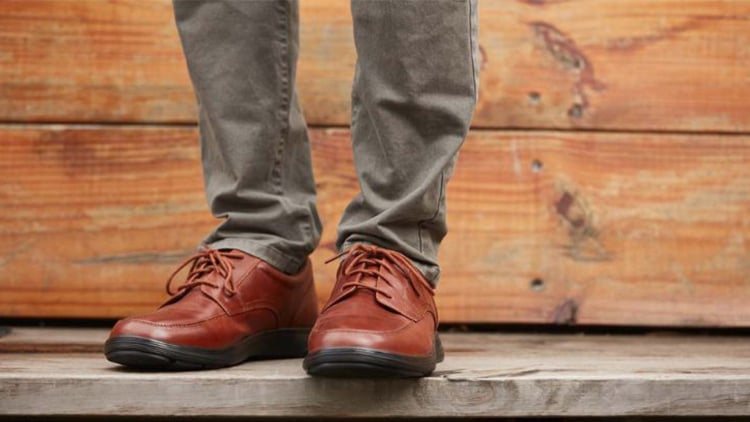
If you have diabetes, you know how important it is to take care of your feet. Foot conditions like diabetic neuropathy, circulation issues, calluses, ulcers and infections can cause a ton of damage and lead to amputations.
As you'll see below, regular shoes can exacerbate the issue. You'll also see the positive difference that diabetic shoes can make in contrast to regular ones. There are so many benefits. Where do we even start? We should discuss why regular shoes may not be ideal for your needs. Read on to find out more.
Why Shouldn’t You Wear Regular Shoes?
Regular shoes are alright. They just aren't created to suit the needs of people with diabetes. Read on below for more information about how regular shoes may not fit your feet best.
Constricted Movement
Constricted movement is a problem you'll struggle with when wearing regular shoes, especially when experiencing edema or swelling of the feet. Simply put, you need extra depth/more room inside your shoes. Unfortunately, if shoes are too tight and rub against your feet, this can lead to callusing and ulcerations. This is a huge issue when you're struggling with diabetes.
Less Support for Your Arch
There's usually less supportive inserts/insoles that come along with regular shoes. These types of arch supports are typically too thin, too soft, or some combination of both. Improper arch support can create a variety of serious complications for anyone’s feet, but especially for diabetics (charcot deformity, plantar fasciitis, etc).
Tightness Around the Ankle
When your legs don't get the proper circulation, you risk developing diabetic neuropathy: nerve damage that causes shooting pain in the extremities, most notably the arms, legs, and feet. Tightness around your ankles could cause many cascading problems, from pain and swelling to tissue necrosis, which is the literal death of the cells in your tissue—in this case, from your ankles down. That can lead to foot or toe amputations.
What Are the Features of Diabetic Shoes?
Diabetic shoes have many useful features. We'll go over each below and show you why people with diabetes think they are an excellent choice for their lifestyle. They boast many benefits.
Extra Room
We discussed the necessity of good circulation in the above section on shoe tightness. It shouldn't be surprising that diabetic shoes have extra room to combat problems associated with restriction. Diabetic shoes are wide and possess a "roominess" that encourages good circulation. As such, movement isn't restricted, so if you already have issues with diabetic neuropathy, you won't exacerbate the problem. You'll give your feet more time to heal.
More Durability
Despite their softness—we'll get into that in a second—quality diabetic shoes are also durable. They won't fall apart on you and can handle normal wear and tear. Additionally, diabetic shoes typically have more protective components than a traditional shoe (rigid heel counter, protective toe box, supportive shank, etc). Medicare, private insurance, and other health plans typically pay for one pair of shoes per year, so your shoes should last you at least 12 months.
Keep in mind that you'll use your shoes and diabetic slippers daily, both in and outside the house. This means you'll use them far more frequently than a person who wears regular shoes. Because of this, manufacturers build diabetic shoes to deal with a lot of wear and tear.
Deep Toe Box
The deep toe box gives your toes room to breathe and prevents pressure and rubbing on your toes. Anything that will take pressure off is perfect since people with diabetes struggle with foot wounds more often than a regular person. Bruising, black spots, callouses, and corns are all threats to a person who wears ill-fitting regular shoes. This is even more pertinent when we discuss a person who has diabetes. Their feet are very delicate, so it's much easier to deal with these conditions. This is one of the ways why diabetic shoes are different than regular shoes.
Advanced Level of Comfort and Softness
Diabetic shoes are optimized for comfort. The material is soft, both inside and out. It provides the freedom of movement to make your travels as comfortable as possible. Remember, you'll wear these shoes everywhere. Another benefit is that you can get diabetic shoes tailored to your feet. While you can buy them online, your insurance may partially pay for them if you are exhibiting at-risk foot conditions.
Style Options
Contrary to what you would maybe think, there are a variety of diabetic shoe style options. Nowadays you can perfectly tailor styles and colors to your fashion desires.
Prevention of Analogous Conditions
We've briefly touched on corns, callouses and ulcers. Now it's time to bring it all together. All the features we've mentioned above make it less likely for these unfavorable foot conditions to happen. Since there's no pressure exerted on the foot due to a deep toe box, corns and callouses become less of a problem.
Overall, the differences are clear. We can only come to one conclusion: diabetic shoes are superior for people with diabetes. Here at Anodyne, we strive to make the best diabetic shoes for your needs. Shop our newest styles today! If you have any questions on "What makes a diabetic shoe?", contact us!



.png?width=116&name=Anodyne_circle_1_logo%20(2).png)
